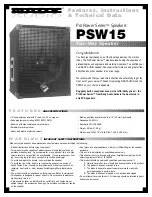
Inland mode
Page 65
The additional identification information can be entered via the ‘
Voyage data
settings’
menu.
The voyage destination should be entered using UN terminal location codes
and ERI terminal codes where possible when in Inland Mode
5.1.4
Inland alarm masking
Inland AIS installations do not typically include connection of external GNSS,
Heading or Rate of Turn sensors to the AIS transceiver. The system alarms
associated with these sensors can be disabled in Inland mode through the
‘Alarms’
screen.
5.1.5
Blue Sign switch
When operating in Inland mode it is possible to connect a ‘Blue Sign’ switch to
the AIS transceiver.
The AIS transceiver provides an isolated input for Blue Sign switch
connection. It comprises two connections BLUE_SIGN_P and
BLUE_SIGN_N. When enabled for Inland Waterways operation and the
BLUE_SIGN_P terminal has a positive voltage with respect to BLUE_SIGN_N
the Blue Sign status will be present on the display and transmitted accordingly
in AIS position reports. See Figure 27.
Suitable options for connection to the Blue Sign interface are shown in Figure
27.
Settings for the Blue Sign switch are available by selecting the
‘Home’ >
‘System settings’ > 'Operating mode’
menu.
Select the ‘
Blue Sign switch’
option to set up the Blue Sign switch.
!
Neither Blue Sign terminal should be connected to any
other point on the AIS transceiver side of any isolation
barrier present in the vessel wiring.
Summary of Contents for CLA2000
Page 1: ...CLA2000 CLASS A AIS TRANSPONDER Installation and Operation Manual...
Page 10: ...Table of contents Page 8...
Page 18: ...Notices Page 16...
Page 20: ...Introduction Page 18...
Page 26: ...Installation and configuration Page 24 Figure 5 Desk mounting the AIS transceiver...
Page 42: ...Installation and configuration Page 40...
Page 86: ...Technical information Page 84...
Page 98: ...Technical specification Page 96...
Page 102: ...Installation record Page 100...
Page 103: ......
















































